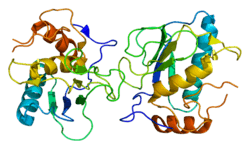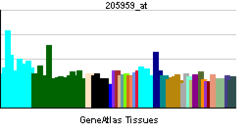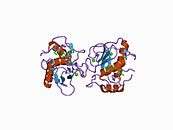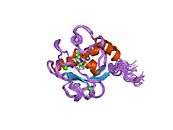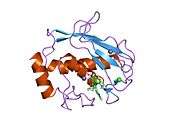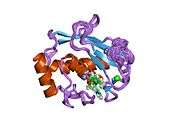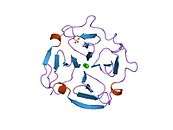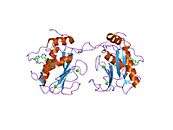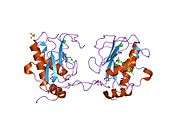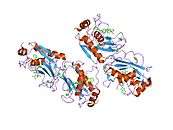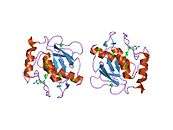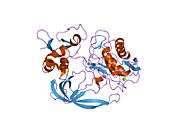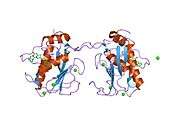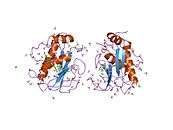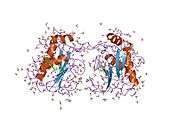Matrix metallopeptidase 13
| View/Edit Human | View/Edit Mouse |
Collagenase 3 is an enzyme that in humans is encoded by the MMP13 gene.[3][4] It is a member of the matrix metalloproteinase (MMP) family. Like most MMPs, it is secreted as an inactive pro-form. It is activated once the pro-domain is cleaved, leaving an active enzyme composed of the catalytic domain and the hemopexin-like domain PDB: 1PEX. Although the actual mechanism has not been described, the hemopexin domain participates in collagen degradation, the catalytic domain alone being particularly inefficient in collagen degradation. During embryonic development, MMP13 is expressed in the skeleton as required for restructuring the collagen matrix for bone mineralization. In pathological situations it is highly overexpressed; this occurs in human carcinomas, rheumatoid arthritis and osteoarthritis.[5]
Proteins of the matrix metalloproteinase (MMP) family are involved in the breakdown of extracellular matrix in normal physiological processes, such as embryonic development, reproduction, and tissue remodeling, as well as in disease processes, such as arthritis and metastasis. Most MMPs are secreted as inactive proproteins which are activated when cleaved by extracellular proteinases. The protein encoded by this gene cleaves type II collagen more efficiently than types I and III. It may be involved in articular cartilage turnover and cartilage pathophysiology associated with osteoarthritis. The gene is part of a cluster of MMP genes which localize to chromosome 11q22.3.[4]
References
- ↑ "Human PubMed Reference:".
- ↑ "Mouse PubMed Reference:".
- ↑ Freije JM, Diez-Itza I, Balbin M, Sanchez LM, Blasco R, Tolivia J, Lopez-Otin C (Jul 1994). "Molecular cloning and expression of collagenase-3, a novel human matrix metalloproteinase produced by breast carcinomas". J Biol Chem. 269 (24): 16766–73. PMID 8207000.
- 1 2 "Entrez Gene: MMP13 matrix metallopeptidase 13 (collagenase 3)".
- ↑ Johansson N, Ahonen M, Kähäri VM (2000). "Matrix metalloproteinases in tumor invasion.". Cell Mol Life Sci. 57 (1): 5–15. doi:10.1007/s000180050495. PMID 10949577.
Further reading
- Nagase H, Woessner JF (1999). "Matrix metalloproteinases.". J. Biol. Chem. 274 (31): 21491–4. doi:10.1074/jbc.274.31.21491. PMID 10419448.
- Leeman MF, Curran S, Murray GI (2003). "The structure, regulation, and function of human matrix metalloproteinase-13.". Crit. Rev. Biochem. Mol. Biol. 37 (3): 149–66. doi:10.1080/10409230290771483. PMID 12139441.
- Pendás AM, Matilla T, Estivill X, López-Otín C (1995). "The human collagenase-3 (CLG3) gene is located on chromosome 11q22.3 clustered to other members of the matrix metalloproteinase gene family.". Genomics. 26 (3): 615–8. doi:10.1016/0888-7543(95)80186-P. PMID 7607691.
- Maruyama K, Sugano S (1994). "Oligo-capping: a simple method to replace the cap structure of eukaryotic mRNAs with oligoribonucleotides.". Gene. 138 (1-2): 171–4. doi:10.1016/0378-1119(94)90802-8. PMID 8125298.
- Mitchell PG, Magna HA, Reeves LM, et al. (1996). "Cloning, expression, and type II collagenolytic activity of matrix metalloproteinase-13 from human osteoarthritic cartilage.". J. Clin. Invest. 97 (3): 761–8. doi:10.1172/JCI118475. PMC 507114
 . PMID 8609233.
. PMID 8609233. - Knäuper V, Will H, López-Otin C, et al. (1996). "Cellular mechanisms for human procollagenase-3 (MMP-13) activation. Evidence that MT1-MMP (MMP-14) and gelatinase a (MMP-2) are able to generate active enzyme.". J. Biol. Chem. 271 (29): 17124–31. doi:10.1074/jbc.271.29.17124. PMID 8663255.
- Gomis-Rüth FX, Gohlke U, Betz M, et al. (1997). "The helping hand of collagenase-3 (MMP-13): 2.7 A crystal structure of its C-terminal haemopexin-like domain.". J. Mol. Biol. 264 (3): 556–66. doi:10.1006/jmbi.1996.0661. PMID 8969305.
- Knäuper V, Cowell S, Smith B, et al. (1997). "The role of the C-terminal domain of human collagenase-3 (MMP-13) in the activation of procollagenase-3, substrate specificity, and tissue inhibitor of metalloproteinase interaction.". J. Biol. Chem. 272 (12): 7608–16. doi:10.1074/jbc.272.12.7608. PMID 9065415.
- Pendás AM, Balbín M, Llano E, et al. (1997). "Structural analysis and promoter characterization of the human collagenase-3 gene (MMP13).". Genomics. 40 (2): 222–33. doi:10.1006/geno.1996.4554. PMID 9119388.
- Suzuki Y, Yoshitomo-Nakagawa K, Maruyama K, et al. (1997). "Construction and characterization of a full length-enriched and a 5'-end-enriched cDNA library.". Gene. 200 (1-2): 149–56. doi:10.1016/S0378-1119(97)00411-3. PMID 9373149.
- Willmroth F, Peter HH, Conca W (1998). "A matrix metalloproteinase gene expressed in human T lymphocytes is identical with collagenase 3 from breast carcinomas.". Immunobiology. 198 (4): 375–84. doi:10.1016/s0171-2985(98)80046-6. PMID 9562863.
- Lovejoy B, Welch AR, Carr S, et al. (1999). "Crystal structures of MMP-1 and -13 reveal the structural basis for selectivity of collagenase inhibitors.". Nat. Struct. Biol. 6 (3): 217–21. doi:10.1038/6657. PMID 10074939.
- Barmina OY, Walling HW, Fiacco GJ, et al. (1999). "Collagenase-3 binds to a specific receptor and requires the low density lipoprotein receptor-related protein for internalization.". J. Biol. Chem. 274 (42): 30087–93. doi:10.1074/jbc.274.42.30087. PMID 10514495.
- Lauer-Fields JL, Tuzinski KA, Shimokawa K, et al. (2000). "Hydrolysis of triple-helical collagen peptide models by matrix metalloproteinases.". J. Biol. Chem. 275 (18): 13282–90. doi:10.1074/jbc.275.18.13282. PMID 10788434.
- Hiller O, Lichte A, Oberpichler A, et al. (2000). "Matrix metalloproteinases collagenase-2, macrophage elastase, collagenase-3, and membrane type 1-matrix metalloproteinase impair clotting by degradation of fibrinogen and factor XII.". J. Biol. Chem. 275 (42): 33008–13. doi:10.1074/jbc.M001836200. PMID 10930399.
- McQuibban GA, Gong JH, Tam EM, et al. (2000). "Inflammation dampened by gelatinase A cleavage of monocyte chemoattractant protein-3.". Science. 289 (5482): 1202–6. doi:10.1126/science.289.5482.1202. PMID 10947989.
- Terp GE, Christensen IT, Jørgensen FS (2000). "Structural differences of matrix metalloproteinases. Homology modeling and energy minimization of enzyme-substrate complexes.". J. Biomol. Struct. Dyn. 17 (6): 933–46. doi:10.1080/07391102.2000.10506582. PMID 10949161.
- Nakamura H, Fujii Y, Inoki I, et al. (2001). "Brevican is degraded by matrix metalloproteinases and aggrecanase-1 (ADAMTS4) at different sites.". J. Biol. Chem. 275 (49): 38885–90. doi:10.1074/jbc.M003875200. PMID 10986281.
